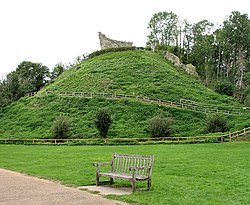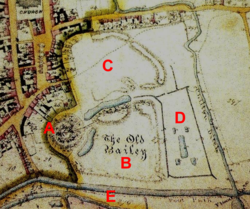Clare Castle
| Clare Castle | |
|---|---|
| Clare,Suffolk,England | |
 Motte of Clare Castle | |
| Coordinates | 52°04′36″N0°34′58″E/ 52.0768°N 0.5829°E |
| Grid reference | grid referenceTL771452 |
| Type | Motte and bailey |
| Site information | |
| Owner | Clare Town Council |
| Open to the public | Yes |
| Condition | Ruined; motte and outer bailey survive |
| Site history | |
| Materials | Flintand rubble |
Clare Castleis a high-mounted ruinousmedievalcastle in the parish and formermanorofClareinSuffolk,England,anciently thecaputof afeudal barony.It was built shortly after theNorman Conquest of Englandin 1066 byRichard Fitz Gilbert,having highmotte and baileyand later improved in stone. In the 14th century it was the seat ofElizabeth de Clare,one of the wealthiest women in England, who maintained a substantial household there. The castle passed into the hands of the Crown and by 1600 was disused. The ruins are an unusually tall earthen motte surmounted by tall remnants of a wall and of the round tower, with large grassland or near-rubble gaps on several of their sides. It was damaged by an alternate line of theGreat Eastern Railwayin 1867, the rails of which have been removed.
The remains are ascheduled monumentand a Grade II*listed building.They form the centrepiece of a public park.
History
[edit]11th–13th centuries
[edit]Soon after theNorman conquest of England,Richard Fitz Gilbertwas granted a barony byWilliam the Conqueror,with two blocks of land, first inKentand later acrossSuffolkandEssex.[1]Richard built two castles to defend his new lands,Tonbridgein Kent, followed by Clare Castle in Suffolk.[2]The exact date of the construction is unknown, but the first documentary records of the castle appear by 1090.[3]In the 11th century, Suffolk was one of the most prosperous parts of the country.[4]

Clare Castle was built between theRiver Stourand the Chilton Stream and took the form of amotte and baileydesign, with two baileys rather than the more common one.[5]The motte is 850 feet (260 m) wide at the base and 100 feet (30 m) tall, with its flat summit 63 feet (19 m) across.[5]The two baileys, stretching alongside from the motte along the north and east, were protected by deep ditches and steeppalisades,with either a causeway or adrawbridgelinking the inner to the outer bailey; the inner bailey was also sheltered by the curve of the Chilton.[6]
The castle was built on the site of a former Anglo-Saxon manor house, probably reflective of the wider Norman effort to demonstrate that their authority had replaced those of the previous lords.[7]Clare Castle was thecaputof thefeudal baronyof Clare, and as historian Robert Liddiard describes, as well as having a defensive value it also "represented and reflected the rank and dignity of the lord".[8]The castle was surrounded by threedeer parks,including the Great Park at Hundon, established by 1090.[9]Like many other major castles, Clare was provided with a nearby religious house whenRichard de Clare, 6th Earl of GloucesterfoundedClare Prioryin 1249, close to the castle, which grew to contain 29friars.[10]
A new keep was built, probably in the 13th century. This took the form of apolygonalshell keep,with fourteen triangularbuttressessupporting six feet (1.8 m) thick walls.[11]The inner bailey was strengthened with new stone walls, 20 to 30 feet (6.1 to 9.1 m) tall on top of the earlier earth banks, the walls and keep being built offlintand rubble.[12]The castle was manned during this period by acastle-guardsystem, in which lands were granted to local gentry for thefeudal tenureof providing knights and soldiers to serve at the castle.[13]
14th century
[edit]
By the early 14th century, before the outbreak of theBlack Death,the town of Clare had a population of around 600.[14]The de Clares continued to own estates across England, but in Suffolk their possessions were concentrated in estates situated around Clare Castle.[15]The castle was passed down the de Clare line untilGilbert de Clare, 8th Earl of Gloucesterdied at theBattle of Bannockburnin 1314, when the estate passed to his sisters.[16]Elizabeth de Clare,whose husbandJohn de Burghhad died the previous year, acquired the castle and the combined estates made her one of the wealthiest women in England.[16]Elizabeth used the castle as her main residence between 1322 and 1360.[17]
The castle was well developed by this time, and was reached through three gates positioned across the wider estate, called Nethergate (memorialised by today's Nethergate Street), Redgate and Dernegate.[18]The castle itself had four stone towers protecting the entrance to the inner bailey and the keep, called Auditorstower, Maidenstower, Constabletower and Oxfordtower.[18]Elizabeth built a chamber for her own use at the castle between 1346 and 1347.[19]A substantial water-garden, forming part of the moat to the east, existed at the castle during this period; it may have included a fountain and probably had a geometric form, possibly similar to the garden at nearbySt Benet's AbbeyinNorfolk.[20]Vineyardsandorchardssurrounded the property.[18]The castle's three parks continued in active use, and as part of the breeding programme, thedeerwere moved between them as they grew older.[21]
The castle and estates supported a luxurious, wealthy lifestyle by their owners – Elizabeth had an income of approximately £3,500 a year, most of which was spent on supporting her household, centred on Clare.[17][nb 1]Over £1,750 was spent on food and drink, including luxuries such asswans,salmonandGerman wines.[17][nb 2]Some goods could be bought locally, but others, such as furs, spices, cloth and wine, were imported for the castle through the international fairs held atBury St Edmunds,Colchester,Ipswich,London,King's Lynnand theStourbridge Fair.[23]The staff at Clare Castle included falconers, tailors, chaplains and goldsmiths, supported as necessary by 30 knights and squires.[24]The castle's bakers could produce up to 2,360 loaves of bread a day, and on average around 900 gallons (4,091 litres) ofalewere brewed every five days.[25][nb 3]
15th–21st centuries
[edit]
After Elizabeth de Clare's death, Clare Castle passed by marriage to the son of Edward III, Lionel of Antwerp,[27]and again by marriage to the Mortimers of Wigmore.[16]When SirEdmund Mortimeracquired the castle in 1405, contemporaries reported it "in good repair and stocked".[16]The subsequent years saw the Mortimers heavily involved in theWars of the Roses;after Edmund's death in 1425, the castle passed toRichard of Yorkand in turn, via his sonEdward IV,to the Crown.[16]Early in the reign of Edward IV, on 1 June 1461, the castle was part of a large estate gifted by the king to his mother, Cecily Neville, dowager Duchess of York, who did use the castle, but not as a main residence.[28]Her half sister, Margaret Neville Scrope, resided in the castle until her death in 1463, and was buried at Clare Priory.
The castle deteriorated during this period. The masonry of the castle had probably been stripped for use as local building materials, as this part of England was traditionally very short of suitable stone.[16]Edward VIgave the castle to Sir John Checke, until it reverted toMary I.[16]After Mary, the castle was acquired by Sir Gervase Elwes, whose family retained it until the 19th century.[16]At some point after 1720, the surviving east and south sides of the inner bailey walls were destroyed.[3]
In 1867 the Cambridge and Colchester branch line of theGreat Eastern Railwaywas built through the castle, cutting across and largely destroying the inner bailey in order to make room fora new station.[29][nb 4]The railway line was later closed in 1967 as part of theBeeching Axe.[31]

The castle now consists of a motte, on which a part of the keep still stands and the outer bailey earthworks; fragments of the inner bailey stone wall can also still be seen.[3]The disused station, goods yard and the castle grounds have been developed into a landscaped country park, interlaced with water in the old moats, calledClare Castle Country Park,which is crossed by theStour Valley Path.The park was opened in June 1972, after 15 acres (6.1 ha) were donated by Anthony de Fontblanque and 4.5 acres (1.8 ha) of railway land bought for £10,000.[32]
In 2014, the keep and curtain wall were extensively consolidated with the assistance of English Heritage.[33]In March 2015, the stewardship of the park transferred fromSuffolk County Councilto the Clare Town Council; atrustmanages the park with the support of local volunteers.[34]The castle is protected under UK law as ascheduled monumentand a Grade 2*listed building.
See also
[edit]Notes
[edit]- ^It is impossible to accurately compare 14th century and modern prices or incomes. For comparison, £3,500 represents several times the typical average annual income for an early 15th-century baron.[22]
- ^It is impossible to accurately compare 14th century and modern prices or incomes. For comparison, £1,750 represents over one and half times the typical average annual income for an early 15th-century baron.[22]
- ^One of the reasons for the high quantities of bread produced was because it was common to pay wages in the form of bread during this period.[26]
- ^A 15th-century gold pectoral cross was found during the building work, which was given toQueen Victoria.[30]
References
[edit]- ^Pounds, p.61; Mortimer, pp.119-141, cited Green, p.6.
- ^Pounds, p.61.
- ^abcClare Castle,National Monuments Record,English Heritage,accessed 2 July 2011.
- ^Dyer, p.63.
- ^abWall, p.595.
- ^Wall, p.595 Tymms, p.65;Clare Castle,National Monuments Record,English Heritage,accessed 2 July 2011.
- ^Liddiard (2005a), p.36; Liddiard (2005b), p.30.
- ^Liddiard (2005b), p.41.
- ^Hoppit, p.152; Harper-Bill, p.39.
- ^Emery, p.78; Liddiard (2005a), p.38.
- ^Tymms, p.65.
- ^Tymms, pp.65-6.
- ^King, p.16.
- ^Bailey, p.129.
- ^Bailey, p.17.
- ^abcdefghMackenzie, p.276.
- ^abcBailey, p.18.
- ^abcUnderhill, p.67.
- ^Emery, p.78.
- ^Liddiard (2005a), p.41; Liddiard (2005b), p.114.
- ^Liddiard (2005b), p.103.
- ^abPounds, p.148.
- ^Holmes, p.111.
- ^Bailey, pp.18-9.
- ^Underhill, pp.68-70.
- ^Underhill, p.68.
- ^Mortimer, Ian.The Perfect King: The Life of Edward III, Father of the English Nation.
- ^Ashdown-Hill, john (2006). "Suffolk connections of the House of York".Proceedings of the Suffolk Institute of Archaeology & History.41(2): 199–207 – via Archaeology Data Service.
- ^Way, p.60.
- ^Way, p.61.
- ^Branch Line,The Reshaping of the Stour Valley Line, V. W. Hinkley, accessed 26 July 2011.
- ^East Anglian Daily Times, 15 June 1975
- ^http://www.clare-uk.com/userdata/files/clare_castle_restoration_works.pdfClare Castle Country Park; Castle Restoration Works,Suffolk County Council, Countryside & Environment Services.
- ^Clare Castle Country Park transfer is complete,Haverhill Echo, accessed 9 August 2017
Bibliography
[edit]- Bailey, Mark. (2010)Medieval Suffolk: An Economic and Social History, 1200–1500.Woodbridge, UK: Boydell Press.ISBN978-1-84383-529-5.
- Dyer, Christopher. (2009)Making a Living in the Middle Ages: The People of Britain, 850 – 1520.London: Yale University Press.ISBN978-0-300-10191-1.
- Emery, Anthony. (2006)Greater Medieval Houses of England and Wales, 1300–1500: Southern England.Cambridge: Cambridge University Press.ISBN978-0-521-58132-5.
- Green, Judith A. (1997)The Aristocracy of Norman England.Cambridge: Cambridge University Press.ISBN978-0-521-52465-0.
- Harper-Bill, Christopher. (ed) (2005)Medieval East Anglia.Woodbridge, UK: Boydell Press.ISBN978-1-84383-151-8.
- Holmes, G. (1957)Estates of the Higher Nobility in Fourteenth Century England.Cambridge: Cambridge University Press.ISBN978-0-521-11654-1.
- Hull, Lise E. (2009)Understanding the Castle Ruins of England and Wales: How to Interpret the History and Meaning of Masonry and Earthworks.Jefferson, US: MacFarland.ISBN978-0-7864-3457-2.
- King, D. J. Cathcart. (1991)The Castle in England and Wales: An Interpretative History.London: Routledge.ISBN0-415-00350-4.
- Liddiard, Robert. (2005a) "The Castle Landscape of Anglo-Norman East Anglia: A regional perspective," in Harper-Bill (ed) (2005).
- Liddiard, Robert. (2005b)Castles in Context: Power, Symbolism and Landscape, 1066 to 1500.Macclesfield, UK: Windgather Press.ISBN0-9545575-2-2.
- MacKenzie, James Dixon. (1896/2009)The Castles of England: Their Story and Structure.General Books LLC.ISBN978-1-150-51044-1.
- Mortimer, R. (1981) "The Beginnings of the Honour of Clare,"Anglo-Norman Studies3, pp. 119–141.
- Page, William. (ed) (1911)The Victoria History of Suffolk, Vol. 1.London: University of London.
- Pounds, Norman John Greville. (1994)The Medieval Castle in England and Wales: a social and political history.Cambridge: Cambridge University Press.ISBN978-0-521-45828-3.
- Tymms, S. (1849) "Clare Castle,"Proceedings of the Suffolk Institute of Archaeology and History1:3, pp. 61–66.
- Underhill, Frances Ann. (1999)For Her Good Estate: The Life of Elizabeth de Burgh.New York: St Martin's Press.ISBN978-0-312-21355-8.
- Underhill, Frances Ann. (2020)For Her Good Estate: The Life of Elizabeth de Burgh, Lady of Clare.London: Moonwort Press.ISBN978-1-9163768-9-2hardback from Clare College Cambridge;ISBN978-1-9163768-0-9paperback.
- Wall, J. C. (1911) "Ancient Earthworks," in Page (ed) (1911).
- Way, Albert. (1868) "Gold Pectoral Cross found at Clare Castle",The Archaeological Journal,25, pp. 60–71.

